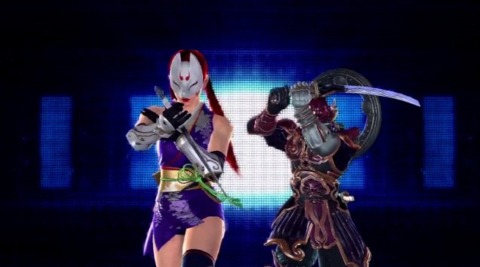Tekken Tag 2 a model of how to handle DLC
Free post-launch characters for Namco Bandai's fighting game respects customers even as they discourage second-hand game sales.
Earlier today, Namco Bandai announced its first wave of downloadable content for Tekken Tag Tournament 2 in the form of four additional characters: Kunimitsu, Ancient Ogre, Michelle, and Angel. In keeping with Tekken series producer Katsuhiro Harada's promise to never charge for extra characters, the quartet--as well as all future Tekken Tag 2 DLC fighters--will be available free of charge.

This marks a refreshing change of approach for Namco Bandai, which has an impeccable track record when it comes to ticking off customers with its DLC. The publisher sold a stripped down DLC-driven version of Ridge Racer for the PlayStation Vita with just five cars and three courses in the core game. It let players pay for level-ups and gold in Tales of Vesperia. It sold Soulcalibur IV with Darth Vader and Yoda on every disc, but charged gamers $5 to unlock one of them depending on which platform they'd purchased the game on.
What Namco Bandai apparently figured out, and what I wish more publishers would realize, is that excessively opportunistic DLC plans may boost revenues in the short term, but inevitably burn through whatever good will a brand has acquired. On the other hand, free DLC works not because it's giving away something for nothing, but because it's treating gamers as a customer to be respected rather than a resource to be exploited.
The trend this generation has been for publishers to use downloadable content to do two things: discourage used game sales, and increase the average revenue per user. The former task is accomplished by giving players new content to look forward to and a reason to hold onto their games rather than sell them back to stores like GameStop. The latter task is accomplished by charging people for the DLC, pushing the total purchase price for the complete experience above the game's full retail cost.
Marketing campaigns have some people so irrationally excited for a game that they're willing to pay more than $60, and this generation has been one long exploration into how much more.
Publishers have seen that their marketing campaigns have some people so irrationally excited for a game that they're willing to pay more than $60, and this generation has been one long exploration into how much more. That's why we see $150 collector's editions, costume bundles, map packs, downloadable costume colors, character progression unlocks, challenge modes, premium subscription services, real-money auction houses (and the anti-consumer always-on DRM that makes such a thing possible), online passes, Xbox Avatar and PlayStation Home items, and toys that interact with games. For every customer and every game, there's a magic number of dollars and cents that they can be convinced to part with, and publishers are doing everything they can to extract that exact amount from gamers, right down to the last dime.
Almost of all of these services, add-ons, or incentives would be fine, if they were implemented with a modicum of respect for the consumer. But they're often combined with one another such that the publisher comes off as a stereotypically sleazy car salesman trying to hard sell a bunch of crap people don't need, extracting money from customers in every way possible. Instead of creating DLC just for the extra revenue, or creating DLC just to keep people from trading a game in, they do both. They make DLC designed to thwart second-hand sales, and then they charge money for it even though it's already serving their interests by keeping the shelves of GameStop from being flooded with used copies.
When publishers charge for DLC that has an unstated goal like stifling second-hand sales, it comes across as disingenuous, manipulative, and disrespectful.
If these same companies would instead just focus on one thing they wanted to do, and did it with a proper amount of care and effort, they would find themselves facing much less anger and resentment from their core audiences. Take Rock Band, for example. Harmonix's rhythm game franchise has more than 3,700 songs available for download. If you want to talk about maximizing the potential average revenue per user, this one's in a class of its own. But at the same time, Rock Band manages to respect the customer in a way few other games have done. The transaction here is always simple, a song or group of songs for a set price. Harmonix gets my $2, and I get to belt out Queen's "Bicycle Race" naked in my apartment at three in the morning. It's a win-win.
And while the Rock Band DLC might discourage used game sales in that you've invested more money in the game and have more reason to hold onto it, that's clearly wasn't the point of the DLC. On the other hand, when a company ships a game with completed DLC locked away on the disc and releases it on a schedule over the course of several months, thwarting trade-ins is a much more transparent motivation.
This gets to a question of being honest with customers. When publishers charge for DLC, their motivation is honest because it's obvious: money. When they don't charge for DLC, their motivation is less relevant, because the customer isn't sacrificing anything to get the content. But when publishers charge for DLC that has an unstated goal like stifling second-hand sales, it comes across as disingenuous, manipulative, and disrespectful.
For Tekken Tag Tournament 2, it appears that Namco Bandai actually gets that, and is being honest with and respectful of its customer base. Now all we need to do is return the favor, and tell them unequivocally that this is the way gamers should be treated.
Got a news tip or want to contact us directly? Email news@gamespot.com
Join the conversation